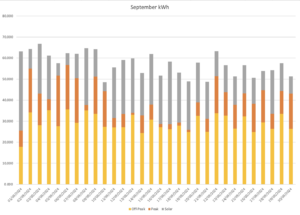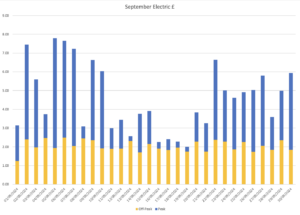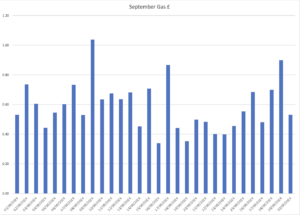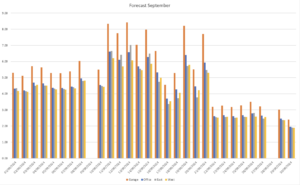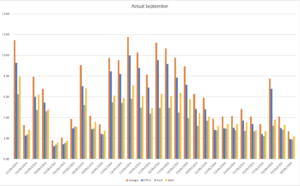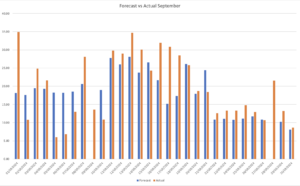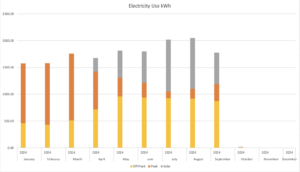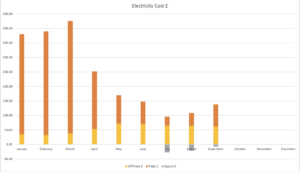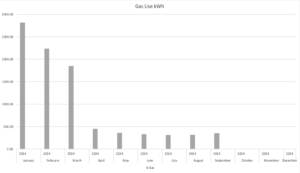This is the fifth full month with the solar being active.
Energy prices remained the same for this month, although there was 1 ‘Free Electricity’ event during the month.
September Electric:
The average daily consumption, including solar, for the month of September was 57.26kWh, we have quite a large variation in solar production from a low of 6.11kWh up to a high of 34.67kWh.
This in turn reflects quite visibly in the cost chart where we have a low of £0.33 and a high of £5.85 for peak electric usage (although some of this was actually ‘free’).
It is easy to see from the Electricity cost graph which days were overcast/wet (or had a free electricity event) as they have much larger dark blue sections, the see-saw/sawtooth pattern for the Off-Peak is again largely due to whether or not the car was charged that night.
The average peak to off-peak percentage usage for the month was 24.28%, so maintaining the desired 25% or better reversal from pre solar, but skewed even more towards peak because of the bad weather.
Average usage: off-peak 29.20kWh, peak 10.42kWh, total 39.62kWh
Average costs: off-peak £2.04, peak £2.54, total £4.82 (including standing charge of £0.4557)
September Gas:
Once again the gas was off for the entire month, highest gas usage was 20.9kWh and the lowest 6.9kWh – £1.04 and £0.34 respectively (including the standing charge of £0.2747).
Average usage: 11.89kWh, average gas tariff was £0.0494.
Average cost: £0.86 (including standing charge of £0.2747)
Total daily energy average cost for September: £5.86 (including standing charges of £0.7304).
Total costs for September were £61.31 off-peak, £76.26 peak, £17.64 gas, £170.51 overall (including standing charge of £22.95).
September 2023 costs were £92.12 off-peak, £402.45 peak, £255.28 gas, £762.36 overall (including standing charge of £20.82).
This is a 77% saving for compared to 2023!
September costs for 2024 using Dec 2023 E-ON tariffs £110.02 off-peak, £108.89 peak, £31.37 gas, £250.27 overall (including standing charge of £31.37).
So the practical saving was £72.48 vs staying on my old E-ON tariffs.
I also had my SEG tariff and was able to export a total of 48.68kWh of electricity at £0.15 per kWh for a total saving of £7.30.
Even worse than last month as we do not appear to be having the best of summers.
I will again use the same assumption as last month of 14.5kWh of battery, there were a few days where I carried some battery charge to the next day, but this was largely insignificant.
So for this month, I have 30 days of solar production which means 14.5kWh x 30 days = 435.0kWh for the batteries that need to ‘swap’ from off-peak to peak rate.
I then produced 590.99kWh of solar, 48.68kWh of which was given back to the grid.
This means that the additional savings for having solar and batteries are (435.0kWh * (£0.2439 – £0.070)) + ((590.99-48.68)kWh) * £0.2439), = (435.0kWh * £0.1739) + (542.31kWh * £0.2439) = £75.66 + £132.29 = £207.95
Which in effect means that I have saved £207.95+ £72.48 + £7.30 = £287.73 compared to my old E-ON tariff and no solar/batteries for the month of September.
These are the graphs of forecast vs actual production:
Not sure why I collected no forecast data for the 9th and 28th, this also happened before in July.
Month on month usage and cost graphs for 2024 (now including exports) for Electricity:
and the same for Gas:
The trend is continuing.
As mentioned at the start of this post, there were a couple of ‘free electricity’ sessions during the month, where the ‘free’ element is any electricity you use, over and above your normal usage as viewed over the past 7-10 days during the hour in question, which was again 13:00 – 14:00.
The sessions were on 10th and 14th of September, this then shows as additional usage on the electricity usage graphs for those days.
I started discharging the batteries around 2 hours prior to the event as I can only export at 4.2kW per hour (limited by DNO agreement), whereas I can charge at up to 9.6kW per hour (3.2kW per battery).
This resulted in me using 7.54 and 5.99kW over and above my normal usage (0.03kW) which in turn equated to savings of £1.84 and £1.46 respectively for a total of £3.30.
This saving can be combined with any exports for that day which included me ‘dumping’ to the grid of 2.18 and 9.32kW for further savings of £0.33, and £1.40 for an additional £1.73 and a total saving of £5.03 over the two sessions.
For the first session, the batteries started at 40% and I managed to discharge them to 26% before charging them up to 86%.
On the second session, the batteries started at 57%, I managed to discharge them to 38% before charging them up to 100%.
Not a huge amount saved, but still about two days worth at my current usage for free.

